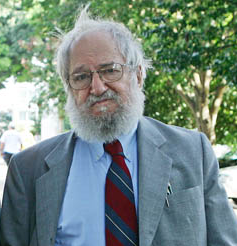|
OLPC XO-1
The OLPC XO (formerly known as $100 Laptop, Children's Machine, 2B1) is a low cost laptop computer intended to be distributed to children in developing countries around the world, to provide them with access to knowledge, and opportunities to "explore, experiment and express themselves" (constructionist learning). The XO was developed by Nicholas Negroponte, a co-founder of MIT's Media Lab, and designed by Yves Behar's Fuseproject company. The laptop is manufactured by Quanta Computer and developed by One Laptop per Child (OLPC), a non-profit 501(c)(3) organization. The subnotebooks were designed for sale to government-education systems which then would give each primary school child their own laptop. Pricing was set to start at $188 in 2006, with a stated goal to reach the $100 mark in 2008 and the 50-dollar mark by 2010. When offered for sale in the Give One Get One campaigns of Q4 2006 and Q4 2007, the laptop was sold at $199. The rugged, low-power computers use flash mem ... [...More Info...] [...Related Items...] OR: [Wikipedia] [Google] [Baidu] |
Quanta Computer
Quanta Computer Incorporated () () is a Taiwan-based manufacturer of notebook computers and other electronic hardware. Its customers include Apple Inc., Dell, Hewlett-Packard Inc., Acer Inc., Alienware, Amazon.com, Cisco, Fujitsu, Gericom, Lenovo, LG, Maxdata, Microsoft, MPC, BlackBerry Ltd, Sharp Corporation, Siemens AG, Sony, Sun Microsystems, Toshiba, Valve, Verizon Wireless, and Vizio. Quanta has extended its businesses into enterprise network systems, home entertainment, mobile communication, automotive electronics, and digital home markets. The company also designs, manufactures and markets GPS systems, including handheld GPS, in-car GPS, Bluetooth GPS and GPS with other positioning technologies. Quanta Computer was announced as the original design manufacturer (ODM) for the XO-1 by the One Laptop per Child project on December 13, 2005, and took an order for one million laptops as of February 16, 2007. In October 2008, it was announced that Acer would phase out Quanta ... [...More Info...] [...Related Items...] OR: [Wikipedia] [Google] [Baidu] |
Geode (processor)
Geode was a series of x86-compatible system-on-a-chip microprocessors and I/O companions produced by AMD, targeted at the embedded computing market. The series was originally launched by National Semiconductor as the Geode family in 1999. The original Geode processor core itself is derived from the Cyrix MediaGX platform, which was acquired in National's merger with Cyrix in 1997. AMD bought the Geode business from National in August 2003 to augment its existing line of embedded x86 processor products. AMD expanded the Geode series to two classes of processor: the MediaGX-derived Geode GX and LX, and the modern Athlon-derived Geode NX. Geode processors are optimized for low power consumption and low cost while still remaining compatible with software written for the x86 platform. The MediaGX-derived processors lack modern features such as SSE and a large on-die L1 cache but these are offered on the more recent Athlon-derived Geode NX. Geode processors tightly integrate some of ... [...More Info...] [...Related Items...] OR: [Wikipedia] [Google] [Baidu] |
501(c)(3)
A 501(c)(3) organization is a United States corporation, trust, unincorporated association or other type of organization exempt from federal income tax under section 501(c)(3) of Title 26 of the United States Code. It is one of the 29 types of 501(c) nonprofit organizations in the US. 501(c)(3) tax-exemptions apply to entities that are organized and operated exclusively for religious, charitable, scientific, literary or educational purposes, for testing for public safety, to foster national or international amateur sports competition, or for the prevention of cruelty to children or animals. 501(c)(3) exemption applies also for any non-incorporated community chest, fund, cooperating association or foundation organized and operated exclusively for those purposes.IR ... [...More Info...] [...Related Items...] OR: [Wikipedia] [Google] [Baidu] |
Fuseproject
Fuseproject is an industrial design and branding firm. Founded in 1999 by designer Yves Béhar, the company works across an array of industries including beauty and fashion, furniture and technology and is based in San Francisco and New York City. History In July 2012, Fuseproject began raising funds on Kickstarter for an open source game console called OUYA, that uses the Android 4.1 operating system, to encourage smaller developers to design games for the platform. In 2014, BlueFocus Communication Group, the biggest agency network in China, acquired Fuseproject in hopes to enter the US market. In 2017, Fuseproject made international news with their design project with Juicero, for the Juicero juicer. The juicer was known for limited functionality and high price, designed with known limitations for the user - putting Fuseproject's design reputation on the line. Awards and recognition Fuseproject work has appeared in various publications, including ''The New York Times'', ' ... [...More Info...] [...Related Items...] OR: [Wikipedia] [Google] [Baidu] |
Yves Behar
{{disambig ...
Yves may refer to: * Yves, Charente-Maritime, a commune of the Charente-Maritime department in France * Yves (given name), including a list of people with the name * ''Yves'' (single album), a single album by Loona * ''Yves'' (film), a 2019 French film See also * Yves Tumor, U.S. musician * * Eve (other) * Evette (other) * Yvette (other) * Yvon (other) * Yvonne (other) Yvonne is a female given name. Yvonne may also refer to: * Yvonne (band), a 1993—2002 Swedish group featuring Henric de la Cour * Yvonne (cow) a German cow that escaped and was missing for several weeks in 2011 * ''Yvonne'' (musical), a 1926 We ... [...More Info...] [...Related Items...] OR: [Wikipedia] [Google] [Baidu] |
Nicholas Negroponte
Nicholas Negroponte (born December 1, 1943) is a Greek American architect. He is the founder and chairman Emeritus of Massachusetts Institute of Technology's Media Lab, and also founded the One Laptop per Child Association (OLPC). Negroponte is the author of the 1995 bestseller ''Being Digital'' translated into more than forty languages. Early life Negroponte was born to Dimitrios Negropontis ( el, Νεγροπόντης), a Greek shipping magnate and alpine skier, and grew up in New York City's Upper East Side. He has three brothers. His elder one, John Negroponte, is the former United States Deputy Secretary of State. Michel Negroponte is an Emmy Award-winning filmmaker. George Negroponte is an artist and was President of the Drawing Center from 2002 to 2007. He attended Buckley School in New York, Fay School in Massachusetts, Le Rosey in Switzerland, and The Choate School (now Choate Rosemary Hall) in Wallingford, Connecticut, from which he graduated in 1961. Subsequent ... [...More Info...] [...Related Items...] OR: [Wikipedia] [Google] [Baidu] |
Constructionism (learning Theory)
Constructionist learning is the creation by learners of mental models to understand the world around them. Constructionism advocates student-centered, discovery learning where students use what they already know, to acquire more knowledge.Alesandrini, K. & Larson, L. (2002). Teachers bridge to constructivism. The Clearing House, 119–121. Students learn through participation in project-based learning where they make connections between different ideas and areas of knowledge facilitated by the teacher through coaching rather than using lectures or step-by-step guidance. Further, constructionism holds that learning can happen most effectively when people are active in making tangible objects in the real world. In this sense, constructionism is connected with experiential learning and builds on Jean Piaget's epistemological theory of constructivism. Seymour Papert defined constructionism in a proposal to the National Science Foundation titled ''Constructionism: A New Opportunit ... [...More Info...] [...Related Items...] OR: [Wikipedia] [Google] [Baidu] |
Access To Knowledge Movement
The Access to Knowledge (A2K) movement is a loose collection of civil society groups, governments, and individuals converging on the idea that access to knowledge should be linked to fundamental principles of justice, freedom, and economic development. History The Berlin Declaration on Open Access to Knowledge in the Sciences and Humanities from 2003 is a major declaration reflecting the goals of the movement pertaining to academic publishing. In October 2004, the Geneva declaration on the future of the World Intellectual Property Organization emerged from a call from Brazil and Argentina for a development agenda for the World Intellectual Property Organization, and was supported by hundreds organizations. Supporters included the Free Software Foundation, with a statement ''Towards a "World Intellectual Wealth Organisation": Supporting the Geneva Declaration.'' One of the proposals of the declaration was to a «call for a Treaty on Access to Knowledge and Technology. The Standi ... [...More Info...] [...Related Items...] OR: [Wikipedia] [Google] [Baidu] |
Laptop
A laptop, laptop computer, or notebook computer is a small, portable personal computer (PC) with a screen and alphanumeric keyboard. Laptops typically have a clam shell form factor with the screen mounted on the inside of the upper lid and the keyboard on the inside of the lower lid, although 2-in-1 PCs with a detachable keyboard are often marketed as laptops or as having a "laptop mode". Laptops are folded shut for transportation, and thus are suitable for mobile use. They are so named because they can be practically placed on a person's lap when being used. Today, laptops are used in a variety of settings, such as at work, in education, for playing games, web browsing, for personal multimedia, and for general home computer use. As of 2022, in American English, the terms ''laptop computer'' and ''notebook computer'' are used interchangeably; in other dialects of English, one or the other may be preferred. Although the terms ''notebook computers'' or ''notebooks'' or ... [...More Info...] [...Related Items...] OR: [Wikipedia] [Google] [Baidu] |
TFT LCD
A thin-film-transistor liquid-crystal display (TFT LCD) is a variant of a liquid-crystal display that uses thin-film-transistor technology to improve image qualities such as addressability and contrast. A TFT LCD is an active matrix LCD, in contrast to passive matrix LCDs or simple, direct-driven (i.e. with segments directly connected to electronics outside the LCD) LCDs with a few segments. TFT LCDs are used in appliances including television sets, computer monitors, mobile phones, handheld devices, video game systems, personal digital assistants, navigation systems, projectors, and dashboards in automobiles. History In February 1957, John Wallmark of RCA filed a patent for a thin film MOSFET. Paul K. Weimer, also of RCA implemented Wallmark's ideas and developed the thin-film transistor (TFT) in 1962, a type of MOSFET distinct from the standard bulk MOSFET. It was made with thin films of cadmium selenide and cadmium sulfide. The idea of a TFT-based liquid-crystal display (L ... [...More Info...] [...Related Items...] OR: [Wikipedia] [Google] [Baidu] |
Grayscale
In digital photography, computer-generated imagery, and colorimetry, a grayscale image is one in which the value of each pixel is a single sample representing only an ''amount'' of light; that is, it carries only intensity information. Grayscale images, a kind of black-and-white or gray monochrome, are composed exclusively of shades of gray. The contrast ranges from black at the weakest intensity to white at the strongest. Grayscale images are distinct from one-bit bi-tonal black-and-white images, which, in the context of computer imaging, are images with only two colors: black and white (also called ''bilevel'' or '' binary images''). Grayscale images have many shades of gray in between. Grayscale images can be the result of measuring the intensity of light at each pixel according to a particular weighted combination of frequencies (or wavelengths), and in such cases they are monochromatic proper when only a single frequency (in practice, a narrow band of frequencies) is ca ... [...More Info...] [...Related Items...] OR: [Wikipedia] [Google] [Baidu] |




